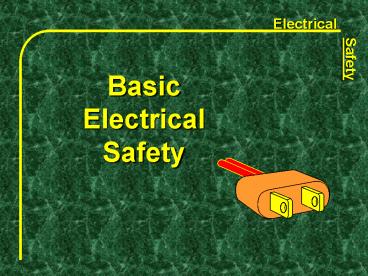Basic Electrical Safety PowerPoint PPT Presentation
1 / 31
Title: Basic Electrical Safety
1
Basic Electrical Safety
2
Basic Electrical Safety
? Course not designed to teach you to work on
electrical equipment.
? You will not be qualified to work
on electrical equipment.
? If you spot problems with electrical equipment
you should report it to your supervisor.
3
Objectives
- Be familiar with the fundamental concepts of
electricity.
- Be familiar with the effects of electricity on
the human body.
- Be able to recognize common electrical
- hazards.
4
Objectives
- Be familiar with electrical protective devices.
5
Fundamentals of Electrical Hazards
- To flow electricity must have a complete path.
- Electricity flows through conductors
- water, metal, the human body
- Insulators are non-conductors
- The human body is a conductor.
6
Fundamentals of Electrical Hazards
Have You Ever Been Shocked?
THE BASICS
7
Fundamentals of Electrical Hazards
? More than 3 ma painful shock ? More than 10
ma muscle contraction no-let-go danger ? More
than 30 ma lung paralysis- usually
temporary ? More than 50 ma possible ventricular
fib. (heart dysfunction, usually fatal) ? 100 ma
to 4 amps certain ventricular fibrillation,
fatal ? Over 4 amps heart paralysis severe
burns. Usually caused by gt600 volts
8
Fundamentals of Electrical Hazards
- Hazards of Electricity
- Electrocution/Shock/Burns/Death
- Minimum distance from overhead lines 10 ft.
- Inspect all electrical tools and equipment
- Frayed, cut, broken wires
- grounding prong missing
- Improper use of cube taps
- improperly applied or missing strain relief
9
Electrical Protection
- Circuit Breakers
- Provided to protect EQUIPMENT not people
- Do not reset breakers with a line voltage higher
than 120V and only reset if you know why it
tripped
- GFCIs
- - Provided to protect people
- - Trip range 4-6ma
- - Monthly test
10
Electrical Protection
- Distance
- If you sense the presence of an electrical hazard
or exposed conductors that may be energized, keep
your distance and STAY AWAY
11
Terminology
12
Electrical Grounding
13
(No Transcript)
14
(No Transcript)
15
(No Transcript)
16
(No Transcript)
17
Fundamentals of Electrical Hazards
- Voltage
- electrical pressure (water pressure)
- Amperage
- electrical flow rate (gallons/min)
- Impedance
- restriction to electrical flow (pipe friction)
18
Fundamentals of Electrical Hazards
- Circuit
- path of flow of electricity
- Circuit Element
- objects which are part of a circuit and
- through which current flows.
- Fault
- current flow through an unintended path.
19
Fundamentals of Electrical Hazards
- What is Grounding?
- Protection from electric shock
- normally a secondary protection measure
- A ground is a conductive connection
- between electrical circuit or equipment and earth
or ground plane - creates a low resistance to the earth.
20
Basic Rules of Electrical Action
- Electricity isnt live until current flows
- Electrical current wont flow until there is a
complete loop, out from and back to the power
source.
21
Preventing Accidental Electrical Contact
Electrocution
Prevention
Path
Electricity
Keep Away
Ground
Time
GFCI
22
Dos and Don'ts
- Do plug power equipment into wall receptacles
with power switches in the Off position. - Do unplug electrical equipment by grasping the
plug and pulling. Do not pull or jerk the cord to
unplug the equipment. - Do not drape power cords over hot pipes,
radiators or sharp objects.
23
Dos and Don'ts
- Do check the receptacle for missing or damaged
parts. - Do not plug equipment into defective receptacles.
- Do check for frayed, cracked, or exposed wiring
on equipment cords.
24
Dos and Don'ts
- Do check for defective cords clamps at locations
where the power cord enters the equipment or the
attachment plug. - Extension cords should not be used in office
areas. Generally, extension cords should be
limited to use by maintenance personnel
25
Dos and Don'ts
- Cheater plugs, extension cords with junction
box receptacle ends or other jury-rigged
equipment should not be used.
26
Dos and Don'ts
- Consumer electrical equipment or appliances
should not be used if not properly grounded.
(Look for the UL Label)
27
Dos and Don'ts
- Employees should know the location of electrical
circuit breaker panels that control equipment and
lighting in their respective areas. Circuits and
equipment disconnects must be identified
28
Dos and Don'ts
- Temporary or permanent storage of any materials
must not be allowed within 3 feet of any
electrical panel or electrical equipment. - Any electrical equipment causing shocks or with
high leakage potential must be tagged with a
Danger tag or equivalent.
29
Myths and Misconceptions
- Electricity takes the path of least resistance.
- Electricity wants to go to ground.
- If an electric tools falls into a sink or tub of
water, the item will short out.
30
Myths and Misconceptions
- AC reverse polarity is not hazardous.
- It takes high voltage to kill 120 volts is not
dangerous. - Double insulated power tools are doubly safe and
can be used in wet and damp locations.
31
(No Transcript)

